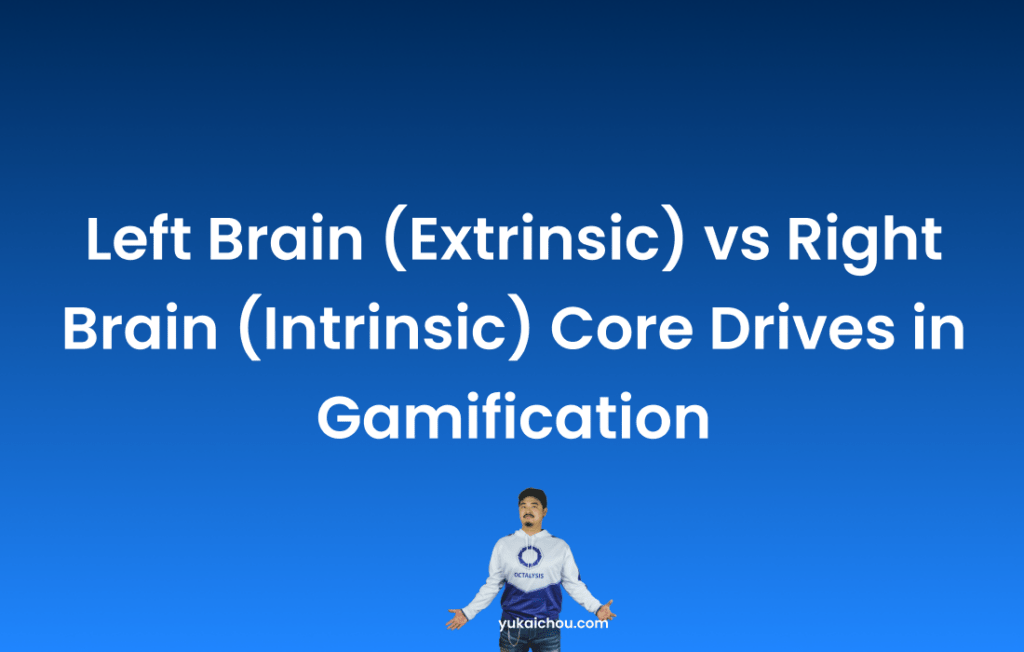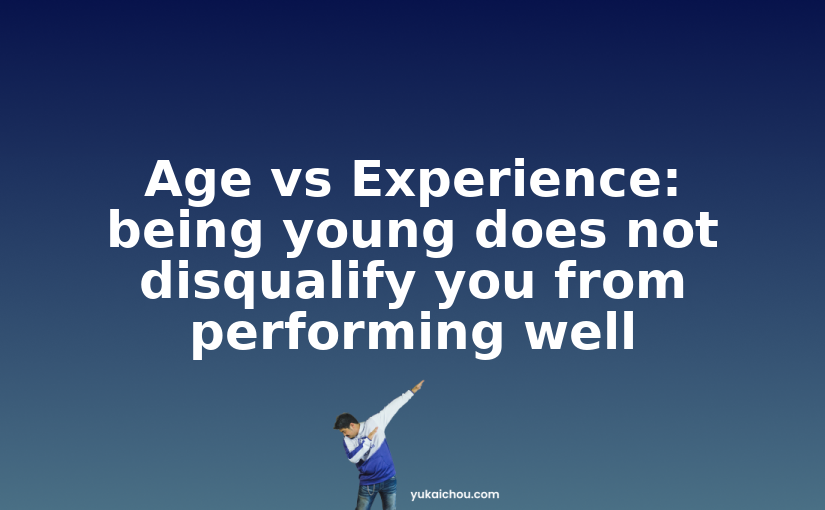(Below is a snippet of Gamification Book: Actionable Gamification – Beyond Points, Badges, and Leaderboards. If you like this blog post, you will LOVE the book.)
Left Brain (Extrinsic) vs Right Brain (Intrinsic) Core Drives in Gamification
A key aspect of the Octalysis Framework is the difference between *Left Brain and Right Brain Core Drives*.
The Left Brain Core Drives involve tendencies related to logic, ownership, and analytical thought. They are expressed in the following three Core Drives:
- Core Drive 2: Development & Accomplishment
- Core Drive 4: Ownership & Possession
- Core Drive 6: Scarcity & Impatience
The Right Brain Core Drives are characterized by creativity, sociality, and curiosity and as illustrated by the following:
- Core Drive 3: Empowerment of Creativity & Feedback
- Core Drive 5: Social Influence & Relatedness
- Core Drive 7: Unpredictability & Curiosity
(Note: there will be several points later in this chapter where you may find the need to refer back to the reference above.)
Not Literally Left or Right Side
Again, it is worth noting that the terminology of “Left Brain Core Drives” and “Right Brain Core Drives” does not necessarily mean that they are physically located on the left side or right side of our brains. These references are merely symbolic in that some of the Core Drives are influenced more by the “logical brain,” while other Core Drives are influenced more by the “emotional brain.”
There have been past instances where some individuals have tried to attack my work, pinpointing how the “left brain vs. right brain” model has been debunked and therefore is no longer scientifically valid. From my perspective, this is simply an issue of semantics, for I could very well name the emotional Core Drives, “Rainbow Core Drives” and the logical Core Drives, “Stone Core Drives” – which would actually give a nice, game-like ring to them.
However, the current terminology is ideal for design purposes, as the “left/right brain” terminology is popularly understood in the social sciences. Therefore I designed the Left Brain Core Drives to be conveniently located on the left side of the octagon and the Right Brain Core Drives to be situated to the right. I’m a designer by trade rather than an academic, so even though I don’t see anything wrong with the Left/Right Brain terminology to begin with, I prefer tools that are useful over ones that are simply semantically accurate.
I believe that my intended goal to organize these Core Drives into intuitive patterns within a visually clear diagram was successful. This allows me and my students to follow complex motivational and behavioral design principles in an approachable manner. In turn, this enables us to design experiences that ensure long-term metrics are sustained.
Conveniently, the Left/Right Brain framework structure also allows us to differentiate and design for the differences between extrinsic and intrinsic motivation.
Extrinsic vs Intrinsic Motivation
The grouping of Left Brain and Right Brain Core Drives with correlated to what many motivational theorists understand as Extrinsic Motivation and Intrinsic Motivation.
Extrinsic Motivation is motivation that is derived from a goal, purpose, or reward. The task itself is not necessarily interesting or appealing, but because of the goal or reward, people become driven and motivated to complete the task. More often than not, people go to work everyday not because they actually love doing the work, but because they want to make a living, advance their careers, and be recognized for higher achievements.
For example, lets say you have a terrible job. Your job is to dig feces out of the ground for hours everyday. It’s labor intensive, smells horrible, and you hate the job with a passion. But then someone shows up and says, “I’ll give you $10,000 for every single piece of dung you dig out.”
All of a sudden, you become excited and extremely motivated to dig, thinking, “Wow! This is easy money! Hahaha!” You’re now engaged, joyful, and motivated with the job. Morale is high, and you start working much faster than you did before.
However, it is important to remember that the *task* itself is still not fun. You are motivated because the extrinsic reward is extremely appealing, and it creates the illusion that you enjoy the activity. Once the extrinsic reward is gone, you will go back to hating the task – and possibly more so than before, as we will see soon.
Intrinsic Motivation, on the other hand, is simply the motivation you get by inherently enjoying the task itself. These are things you would even *pay* money to do because you enjoy doing them so much. For instance, you don’t need to reach any target to enjoy utilizing your creativity; you don’t need a physical reward to enjoy hanging out with your friends; and you don’t need any compensation to be absorbed by the suspense of unpredictability.
In fact, when you go to a casino, you have the opposite of a reward. Most people know that they are “statistically screwed” by the casino – that’s how the casinos make so much money. But they still come out saying, “I lost $200, but I had so much fun!” Why? Because, throughout those five hours, they were constantly thinking, “Maybe I’ll win this time!”
They are spending $200 to buy the intrinsic joy of “possibly” winning. If the unpredictability is removed and people know with absolute certainty that they will get $40 after pressing those buttons for five hours, they will no longer think it is fun. In fact, it would become very similar to the dreadful *work* of laboring in a factory.
Left Brain Core Drives are by nature goal-oriented, while Right Brain Core Drives are experience-oriented. Extrinsic Motivation focuses on results, while Intrinsic Motivation focuses on the process.
Slight Semantic Differences with the Self-Determination Theory
Intrinsic Motivation versus Extrinsic Motivation is a popular topic within the gamification space and was heavily popularized by Daniel Pink’s book Drive. The book explores how instead of being motivated by money (Core Drive 4: Ownership & Possession) and punishment (Core Drive 8: Loss & Avoidance), people are motivated more by *Purpose*, *Autonomy*, and *Mastery*.
While I believe Drive, as well as the Self-Determination Theory it advocates, are fantastic, I should point out that my terminology differs slightly from Pink on what Intrinsic Motivation consists of.
When a basketball player practices by shooting hoops a thousand times a day, their motivation is to achieve Mastery, something that is characterized as Intrinsic Motivation within Pink’s theories. However, within the Octalysis Framework, the activity itself is still monotonous and boring. It is only motivating because the athlete has a goal – an extrinsic motivation. That said, we will look at how Self- Determination Theory connects with White Hat Motivation within my framework in the next chapter.)
Here is the test I usually apply to determine if something is extrinsically or intrinsically motivated: if the goal or objective were removed, would the person still be motivated to take the Desired Action or not?
In other words, at the end of the day, if the basketball player knows that whatever they do, they will lose all “progress” and everything obtained or accumulated, would they still choose to shoot hoops?
Social hangouts and creative activities, such as solving fun puzzles, will pass the test for intrinsic motivation. However, accumulating goods, earning points, or even progressing towards mastery would likely not. What would you spend time doing if you knew the world was surely going to end tomorrow? It would be unlikely that you will decide to practice shooting basketball hoops – though you may decide to play a game of basketball with those you love and care about.
Again, these are simply differences in terminology and grouping, not a fundamental difference in beliefs about what motivates people. Daniel Pink only differentiates between Intrinsic and Extrinsic motivation, while I classify using the extra dimension of White Hat versus Black Hat motivation. (You will see that Mastery falls into the White Hat camp of motivation.) Hence our categorization and language differ slightly, while our overall beliefs in the nature and effectiveness of these drives do not.)
In a similar fashion, Michael Wu, Chief Scientist of the engagement platform Lithium, differentiates between Intrinsic/Extrinsic Motivation and Intrinsic/Extrinsic Rewards.
Motivation is what drives us to do any action, and Rewards are what we obtain once we perform the Desired Action.
A person may receive Intrinsic *Rewards* after performing a certain task, such as gaining the appreciation of others or feeling a sense of accomplishment. However, since Intrinsic *Motivation* is derived from the activity itself without concern for the future outcome, if a person does something for any reward, including any Intrinsic Reward, it is not based on Intrinsic Motivation.
This is slightly tricky to comprehend, but along the lines of Michael Wu’s concepts, Core Drive 2: Development & Accomplishment may utilize Intrinsic Rewards, but ultimately does not focus on Intrinsic Motivation. The Left Brain Core Drives are result (goal) focused, while the Right Brain Core Drives are process (journey) focused. Core Drive 2 focuses on progress and achievements, and as a result is based on Extrinsic Motivation in my framework.








